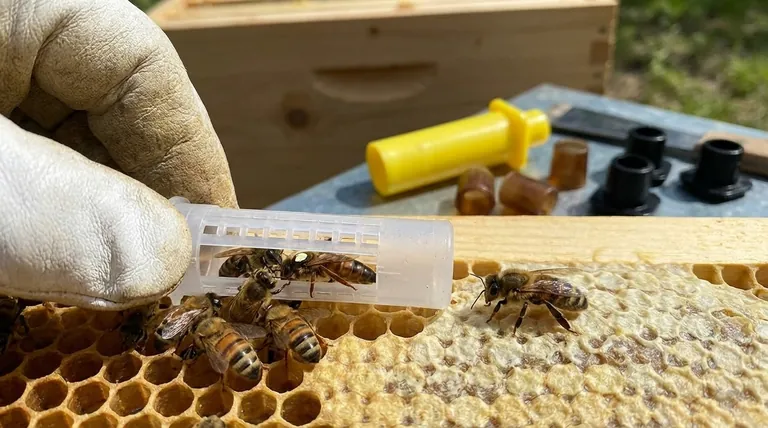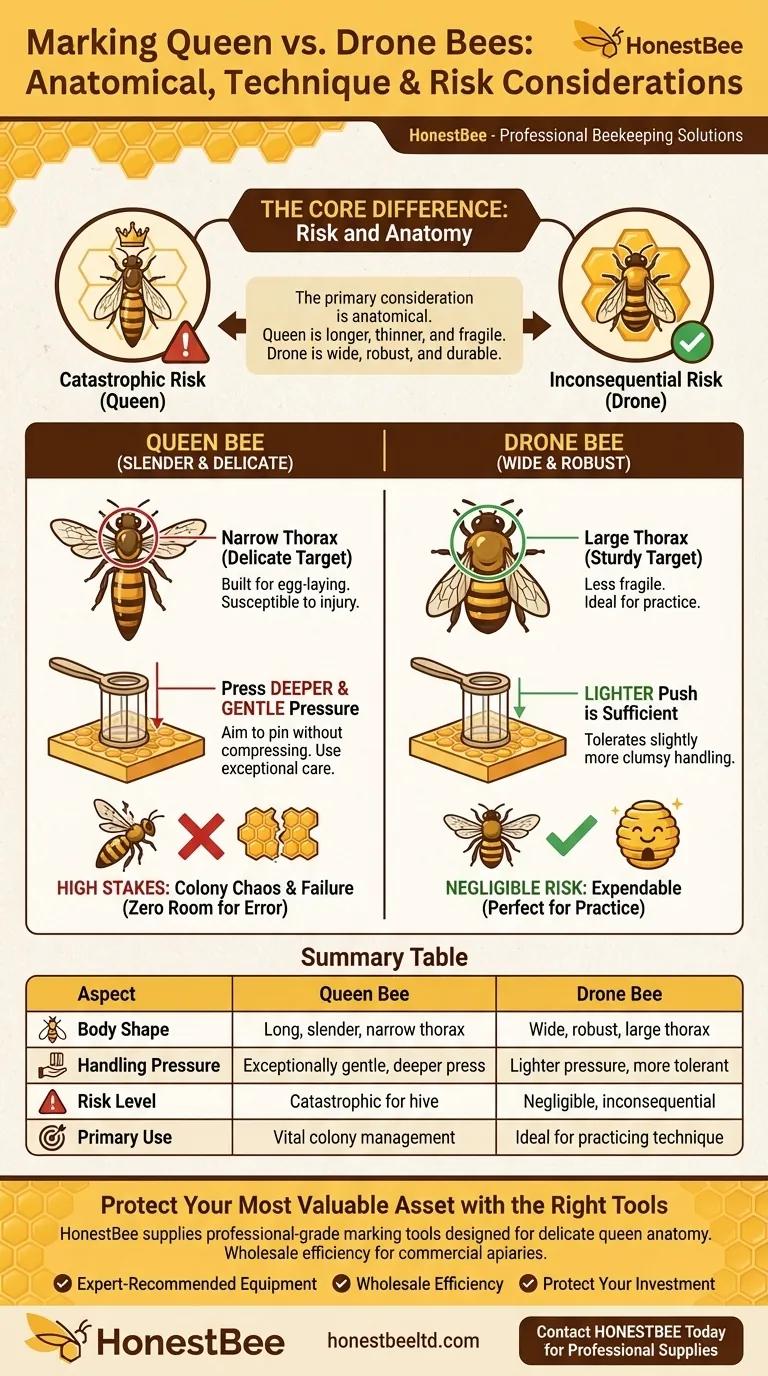When marking a queen versus a drone, the primary consideration is anatomical. A queen's body is longer and thinner, particularly her thorax, which requires you to press the marking cage slightly deeper into the honeycomb to secure her. However, the pressure applied must remain exceptionally gentle to avoid crushing or injuring her, as she is far more delicate than a robust, thick-bodied drone.
The core difference comes down to risk and anatomy. You must adapt your physical technique for the queen's slender, fragile body, understanding that a mistake is catastrophic for the hive, whereas a mistake with a drone is inconsequential.

The Critical Anatomical Differences
The body shape of a queen and a drone directly dictates how you must handle them during the marking process. Their distinct builds require different levels of finesse and caution.
The Queen's Profile
A queen bee is characterized by a long, slender abdomen and a comparatively narrow thorax. The thorax is the target area for marking, and its smaller size makes it a more delicate target.
Her overall structure is built for egg-laying and mobility within the hive, not for brute strength. This makes her susceptible to injury from excessive pressure.
The Drone's Profile
A drone, by contrast, is much wider and more robust. His body is thick, and his thorax is a large, sturdy platform, making it a significantly easier and safer target for marking.
Their build is less fragile, and they can tolerate slightly more clumsy handling without being injured. This makes them ideal subjects for practicing your marking technique.
Adjusting Your Technique and Pressure
The goal is to immobilize the bee without causing harm. Your method must change based on the bee's physical structure and the value it holds for the colony.
Securing the Queen
Because of her thinner body, the marking cage must be pressed a little further into the wax of the comb. This ensures the cage's rim, not your hand, holds her securely against the comb face.
The pressure must be gentle and even. The aim is to pin her without compressing her thorax or abdomen. Think of it as creating a small, temporary enclosure around her rather than pushing down on her.
Handling the Drone
A drone's wide body means the cage does not need to be pressed as deeply into the comb to hold him steady. A lighter push is often sufficient to trap him.
While drones are more durable, it is still best practice to use gentle pressure. This builds the correct muscle memory for when you handle a queen.
Understanding the Stakes: Queen vs. Drone
The most significant difference is not in the technique itself, but in the consequence of failure. This context should inform every movement you make.
The High Cost of a Queen Injury
The queen is the single most important bee in the colony. Injuring or killing her can send the hive into a state of chaos, leading to a broodless period and potential colony failure.
There is zero room for error. The financial and biological cost of replacing a queen is substantial, making caution your highest priority.
The Negligible Risk of a Drone Injury
Drones are, from a colony management perspective, expendable. The loss of a single drone has no measurable impact on the health or survival of the hive.
For this reason, drones are the perfect subjects for beekeepers to practice their marking skills before ever attempting to mark a valuable queen.
How to Apply This to Your Beekeeping
Your approach should be dictated by your goal: are you practicing a skill or managing a vital colony asset?
- If your primary focus is practicing your technique: Always use drones. Their larger size and expendable nature make them the ideal, no-risk training subject to build your confidence and muscle memory.
- If your primary focus is managing your hive: Approach marking a queen with extreme care and deliberation. Ensure you have a steady hand, good lighting, and have practiced sufficiently on drones first.
Ultimately, mastering this skill is about respecting the profound difference in value between these two bees and adjusting your actions accordingly.
Summary Table:
| Aspect | Queen Bee | Drone Bee |
|---|---|---|
| Body Shape | Long, slender abdomen; narrow thorax | Wide, robust body; large, sturdy thorax |
| Handling Pressure | Exceptionally gentle; cage pressed deeper into comb | More tolerant; lighter pressure sufficient |
| Risk Level | Catastrophic for the hive if injured | Negligible; single drone loss is inconsequential |
| Primary Use | Vital colony management | Ideal for practicing marking technique |
Protect Your Most Valuable Asset with the Right Tools
Marking a queen is a high-stakes task that requires precision and the right equipment. At HONESTBEE, we supply commercial apiaries and beekeeping equipment distributors with the durable, gentle marking tools and supplies needed for this critical procedure.
Why choose HONESTBEE for your operation?
- Expert-Recommended Equipment: Our marking cages and paints are designed specifically for the delicate anatomy of queen bees.
- Wholesale Efficiency: Source all your essential beekeeping supplies from one trusted, wholesale-focused partner.
- Protect Your Investment: Using the proper tools minimizes the risk of injuring your valuable queens, ensuring hive productivity and health.
Ready to equip your operation with professional-grade supplies? Contact HONESTBEE today to discuss your needs and ensure the safety of your hive's most important member.
Visual Guide

Related Products
- Nicot Queen Rearing Kit for Beekeeping and Grafting in Nicot System
- Jenter Queen Rearing Kit Complete Set for Bee Breeding
- High Performance Plastic Queen Excluder for Beekeeping and Apiary Management
- No Grafting Queen Rearing Kit: System for Royal Jelly Production and Queen Rearing
- Wooden Queen Bee Excluder for Beekeeping
People Also Ask
- What is essential for successful queen rearing in beekeeping? Master Genetics & Boost Your Apiary's Health
- What should be done once eggs are present in the comb box? A Guide to Maximizing Queen Rearing Success
- What are the methods of queen rearing? Master Grafting, Direct Lay & More
- Can anyone use Queen Rearing with JZBZ? A Beginner-Friendly System for All Beekeepers
- What should be done to ensure grafted larvae are well-fed? Master the Principle of Abundance for Queen Rearing



















